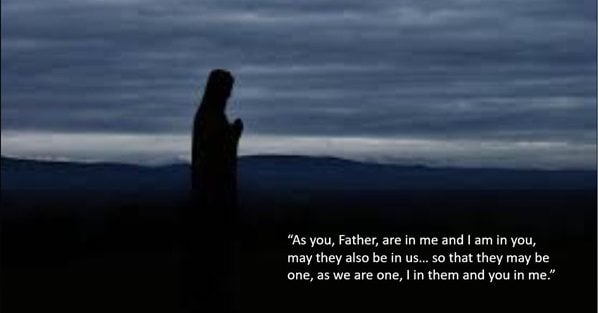This is a sermon I preached at Clackamas United Church of Christ, in Milwaukie, Oregon. The texts were Numbers 21:4-9 and John 3:14-21. You can read the sermon text or watch the video below.
One of my favorite saints is St. Patrick. In part because I love the holiday. I have no Irish blood in me, but when I was in high school, I lied about that. Because on St. Patrick’s Day I always wore one of those stickers that said, “Kiss me. I’m Irish.” Unfortunately, it never worked.
And then I went to college, and that stupid sticker still didn’t work…But one of my professors began writing a book on the saints and he invited me to help research St. Patrick. I was quickly brought into a fascinating story about this saint who lived nearly 1600 years ago.
Patrick wrote an autobiography, but much of what we know about him comes from legend. We know that Patrick was born around the year 387 in Britain. His grandfather and father we both rich Christians of the upper class. Young Patrick had very little interest in God, but he enjoyed his family’s wealth. In his autobiography, he describes his childhood life as, “spoiled and rebellious” and he lived “a life of luxury.”
But when Patrick was 17, his life changed forever when Irish raiders attacked his parents’ home and kidnapped him. The raiders took him to Ireland and sold him as a slave to a tribal chief who forced Patrick to do the dirty, difficult work of tending his sheep.
Patrick had no friends and no one to talk with, except his often cruel slave master. In a foreign land with a foreign language he only gradually began to understand, young Patrick battled depression, doubt, and intense anger that stayed with him throughout his life. But Patrick wrote that it was in this moment of suffering and despair that he turned to God. Alone and in slavery, despite his pain, or maybe precisely because of it, Patrick opened himself to God’s loving presence. And after 6 years of slavery, he had a vision of God telling him it was time to escape his slave master and return home.
Patrick walked 200 miles from his slaveholder’s home to the coast of Ireland, where he found “a ship of reluctant pirates” and convinced them to take him to Britain. After months of traveling, Patrick finally made it home and his parents were overjoyed at his return. They expected him to continue the family tradition that led to wealth, comfort, and privilege.
But Patrick had another vision. Just after telling Patrick to escape Ireland and return home, God now told Patrick he must once again leave his life of privilege behind and go back to Ireland. He must go back to the place that enslaved him. The place that caused him so much pain and trauma. But this time not as a slave, but to spread the message of Christianity to the Irish.
Now, if I were Patrick, I would say, “No way! Those jerks stole six years of my life and caused me so much pain.” But I think this is one of the important lessons from Patrick. You see, we often think that if you do the spiritual life “right” everything will go well for you. God will bless you with all kinds of riches and joy. Today, we call this the “prosperity Gospel.” But that kind of spirituality is false. The spiritual life doesn’t necessarily promise rainbows and a pot of gold. Rather, it sent the Israelites into the difficulties of the desert for 40 years. It sent Jesus into the desert for the 40 days we call Lent. And it sent Patrick back to a place that wasn’t comfortable.
The spiritual life isn’t always easy. It often takes us out of our comfort zones, but like Patrick, if we keep our eyes on God, it can help us realize that there’s something bigger than resentment, bigger than fear, bigger than anger, and bigger than a desire for comfort. And that something bigger is sharing God’s love with others.
Patrick returned to Ireland where legend says he did two extraordinary things. First, helped to convert the Irish from druidism to Christianity. Second, he banished all the snakes from Ireland.
We may ask, what was so wrong with druidism? There is some debate about this, but the Encyclopedia Britannica claims that the druid priests “offered human sacrifices for those who were gravely sick or in danger of death in battle” in hopes the gods would heal them.
Patrick went to Ireland to end those practices. The true God doesn’t want sacrifice, but wants us to end sacrificing ourselves and others. As the prophet Hosea wrote, God doesn’t demand sacrifice. God demands mercy. And so Patrick went to Ireland to end the ways of sacrificing others.
So, in a sense, one can say that Patrick banished the Druidism from Ireland. Which leads us to the second claim that Patrick banished snakes from Ireland. Legend says he was fasting and praying on top of a hill, when a plague of snakes attacked him. He then drove the snakes down the hill, banishing all snakes from Ireland.
Interestingly, we know that the story about the plague of snakes is a myth because snakes haven’t been on Ireland since the glacial age, nearly 1,500 years ago.
Some explain the snake story by saying that the Irish wanted an explanation for why snakes weren’t on the island, so they made up the story of Patrick banishing the snakes. But I think there’s something else going on. The modern anthropologist René Girard says that ancient people often talked about plagues, such as snakes or diseases, metaphorically. Sometimes there really was a brood of snakes or a disease that plagued the ancient peoples. But often the plague was a metaphor for a different kind of plague, the plague of human violence.[1]
So, when the ancients talked about Patrick banishing a plague of violent snakes from Ireland, there’s evidence they were likely talking metaphorically about Patrick banishing the violent practice of human sacrifice from Ireland.
Once I came across this idea, it helped me make sense of some strange passages in the Bible, like our passage today from Numbers. Like Patrick, the Israelites left their lives of slavery behind because God gave them a new vision of freedom. So under the leadership of Moses, they left Egypt and traveled for a grueling forty years in the desert to the promised land.
Life was very difficult in the desert. There was little water and almost not food. The Israelites were tired, hungry, and thirsty as the hot desert sun beat down on them.[2] During these times of social crises, we often complain and find someone to blame for our misery. And that’s what the Israelites did. They united as they complained against Moses and God for taking them out of Egypt and into the struggles of the desert.
It’s important to note that the Israelites didn’t complain against God because they were particularly ungrateful Israelites. That Christian interpretation of the story has infected too much of our history and we need to repent from the anti-Judaic sentiment it creates.
The fact is that any group that experiences inner conflicts and social crises like the Israelites did, often acts like a brood of venomous snakes,[3] attacking one another, until a sense of solidarity is created by uniting our venom against a common enemy, a scapegoat.
That’s what happened to the Israelites. Except you probably noticed that they told the story with a slightly different twist. They claimed that God responded to their complaints by condemning them to snakes attack that killed many of the Israelites. But once the Israelites apologized, God told Moses to create a bronze snake, put it on a pole, and raise it up. Any Israelite who was bitten by a snake would survive the venomous snake bite by looking up at the bronze snake.
But I have a problem with a literal interpretation of this story because, you see, I don’t think God acts that way. I don’t think God is in the condemning business. That’s not because I’m predisposed to making God into a nice, comfortable image of my own making. No, personally, I’d rather that God be in the condemning business because then I can get God on my side to condemn my enemies.
But, according to Jesus, God doesn’t condemn anyone. In our passage today from the Gospel of John, Jesus refers to the story of Moses lifting up the bronze snake that heals everyone who looks at it, but did you notice that Jesus leaves out that whole part about God sending the violent snakes? It’s interesting, because whenever Jesus refers to Hebrew Bible stories, he always leaves out the parts that portray violence within God. He only mentions the parts where God heals people.
That’s because for Jesus, there is no condemnation or violence within God. That’s what the famous passage “For God so loved the world that he sent his son,” means. In Greek, the word for “world” is cosmos. For God so loved the cosmos. God’s love is cosmic. It embraces all people and indeed, all things. And like our passage also claims, God didn’t send Jesus into the world to violently condemn it, but to save it through the love of Jesus.
Which may lead us to ask, what did Jesus come to save us from? Jesus came to save us from plaguing one another with the venom of physical, emotional, and spiritual violence. Jesus didn’t come to save us from God’s condemnation; he came to save us from a cycle of condemning one another. Like Patrick went to Ireland to banish the venomous practice of human sacrifice, like Moses lifted up the bronze snake to save the Israelites from biting one another, Jesus was lifted up on the cross to reveal God’s cosmic love, not God’s cosmic condemnation.
And here’s the clincher for me: If there were any time that God should have sent a plague of snakes in response to people complaining against God, it was at the cross. But Jesus went to the cross, not to appease the wrath or justice of God. Rather, Jesus went to the cross because people were acting like venomous snakes. And how did God respond? Jesus prayed for his persecutors by saying, “Father forgive them, for they know not what they do.”
God doesn’t condemn us by sending snakes in our lives. We are the ones who sometimes act like snakes. And here’s the thing I’ve come to find that’s so important for my spiritual development: It’s always easy for me to see how others act like venomous snakes, but it’s much more difficult for me to see that the venomous snakes exist inside of me, too.
That’s the potential problem with the story of St. Patrick and the story of the Israelites. It can too easily lead us to label “those druids” as snakes because they practiced human sacrifice, or “those Israelites” as snakes because they complained so much. If I accuse the Israelites or the druids, it can easily begin to let me off the hook by seeing the snakes in everyone else except myself.
There may be good reasons for calling out others who act like snakes. But I think the journey of Lent calls us to come face to face with the snakes that exist within each of us. Because once we deal with our inner snakes, we can more authentically and more sympathetically call out the snakes that exist within others.
And even more importantly, only when we acknowledge our inner snakes can we realize that God loves us, truly loves us unconditionally, exactly as we are, even with our inner snakes.
And there’s something else going on in these stories that might be just as important. After all, God tells Moses to have the Israelites look up at the bonze snake. Jesus says that he’s like the bronze snake and people should look up to him when he is lifted up on the cross. So, where we look matters. When we look up to Jesus, we stop looking at each other. Our primary motivation isn’t complaining or being against someone else. Rather, when we look to Jesus, our primary motivation is to participate in the realm of God’s love manifesting here on earth.
So, as we continue our Lenten journey, may we face down our inner snakes.
May we realize that even when our inner snakes act up, God continues to love us and invites us to start again.
And may we keep our eyes on Jesus who was lifted up to reveal God’s love that embraces each if us, and indeed, the entire cosmos. Amen.
[1] See René Girard, especially his book The Scapegoat.
[2] As I wrote that sentence, I realize that I unconsciously wrote about the sun metaphorically. Obviously, the sun did not “beat down on” the Israelites. But like the ancients, we moderns talk metaphorically about the dangers of nature.
[3] Jesus, and John the Baptist before him, also speak metaphorically about snakes, calling some Pharisees a “brood of vipers.”
Copyright: wavebreakmediamicro / 123RF Stock Photo
Stay in the loop! Like Teaching Nonviolent Atonement on Facebook!
















